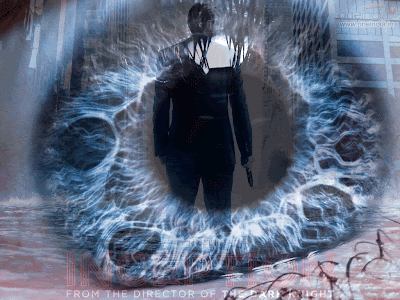Embedded Metaphors
One of the keys to Neuro Linguistic Programming inducing an altered state of consciousness is the use of embedded metaphors. Foundational to NLP theory as it is to the metaphysical underpinnings of the film Inception is the belief in two "minds" within the brain. The conscious and the unconscious. The conscious mind is the rational part of us that is very interested in control. It is logical, rational and limits itself "reality" as it perceives it.
See These Pages:
FUTURISM
TECH TRENDS
SINGULARITY
SCIENCE
CENSORSHIP
SOCIAL NETWORKS
eREADERS
MOBILE DEVICES
FUTURISM
TECH TRENDS
SINGULARITY
SCIENCE
CENSORSHIP
SOCIAL NETWORKS
eREADERS
MOBILE DEVICES
The goal in any inception, according to the film, or NLP therapy, is to reach the unconscious mind directly, through the bypassing of the conscious mind. How is this to be done? In the film, sedative cocktails are used to put the subject into a sleep more. According to researchers during sleep the rational part of our brain is relatively inactive, allowing for the rest of the brain to construct reality without any of the constraints of the "real" world like gravity, etc. Thus the sedatives allow for the unconscious mind to roam at will and create and invent, "pure creation" as Ariadne tells Arthur.
In NLP therapy, the way to reach the unconscious mind it by the use of embedded metaphors, which can be in the form of stories within a stories or the use of visual, or verbal cues. As stated here by David Mason:
Multiple embedded metaphors is a metaphor therapy technique that forces the listener to concentrate on several metaphor stories at the same time. Metaphor therapy can be used to treat most psychological problems because embedded metaphors and stories are able to act directly on the subconscious mind. The multiple embedded metaphor technique wraps one metaphoric story inside another, usually to three levels deep. The hypnotherapist starts a story, gets distracted into another story, then starts another story and doesn't finish that one and leaves the listener hanging on before finishing all the metaphor stories in reverse order. The idea is to force the listener to keep the unfinished metaphoric stories in their mind for longer than normal. The longer the embedded metaphor stays active in the mind the more likely it is to have a therapeutic effect.
"Something you should know about me... about inception...an idea is like a virus resilient, highly contagious... and the smallest seed of an idea can grow...it can grow to define or destroy you."
Cobb
You will notice that Cobb the main character in the film says he needs to go down three levels of dreams within dreams to be able to accomplish the inception. Cobb
Indeed the film plot itself can be seen as a attempt at hypnosis by the use of the embedded or enclosed stories within the main story of the film. Cobb's wife and her suicide is the inner most story, which in turn is surrounded by an outer subplot of the attack on the arctic stronghold of Robert Fischer and the fateful meeting with Fischer's father at his deathbed. This story is in turn surrounded by another, the story that centers in the hotel when Fischer is first convinced not to trust his father's lawyer Peter Browning. That story is surrounded as well, by the car chase scene ending in the van plunging into the river. And this final embedded story is surrounded by another subplot in the plane on the way to Los Angeles, which is "real" and is the flying platform where all these substories will take place resulting in Fischer's decision to sell off his father's companies, resulting in Tadashi's company becoming supreme in the area of energy, which will result in turn in Tadashi's call to his American contacts to erase Cobb's criminal murder indictment, and thus, allow him to be with his children in America.
It should not be surprising that the description of NLP practitioners is so similar to the plot and unfolding of Inception. Storytellers have for centuries understood that something very special happens to an audience enraptured by a story:
The best, the truest storytelling transports us because it is the real thing, not an imitation. What we experience as we listen to true telling is not the suspending of disbelief. Rather, it is an altered state of mind which teller and listeners share. It is as if we were participants in a different reality.Watch this video about embedded stories and the trance they put people in. This trance state allows the speaker to place suggestions directly to the subconscious, very similar to Inception. In case you do not see the embedded youtube video here is the link: http://youtu.be/j7N4aACxdxY.
In the film Inception, Cobb needs healing. He has stuffed all of his guilt into the deep recesses of his subconscious. This has allowed him to function in a seemingly "normal" fashion. But at some point he will need to deal with these monsters from his subconscious. Just like NLP practitioners use these embedded stories to allow people to deal with their deepest guilt, so all these level dreams will eventually allow Cobb to heal himself. All who watch this movie have also gone through a kind of therapy, since all of us can identify with Cobb in some way. When we see him heal himself of his guilt through these embedded stories, we also see the light for our own fears and guilt.
In our next article in this series we will further explore the statement that ideas are like viruses in the example of memes. Are ideas and memes the same? What is a meme? How one tell the difference between "reality" and "dreams"? Do dreams only happen when we sleep?




2 comments:
Thank you, I have recently been searching for information about this topic for ages and yours is the best I have discovered so far.
What a great resource!
Post a Comment